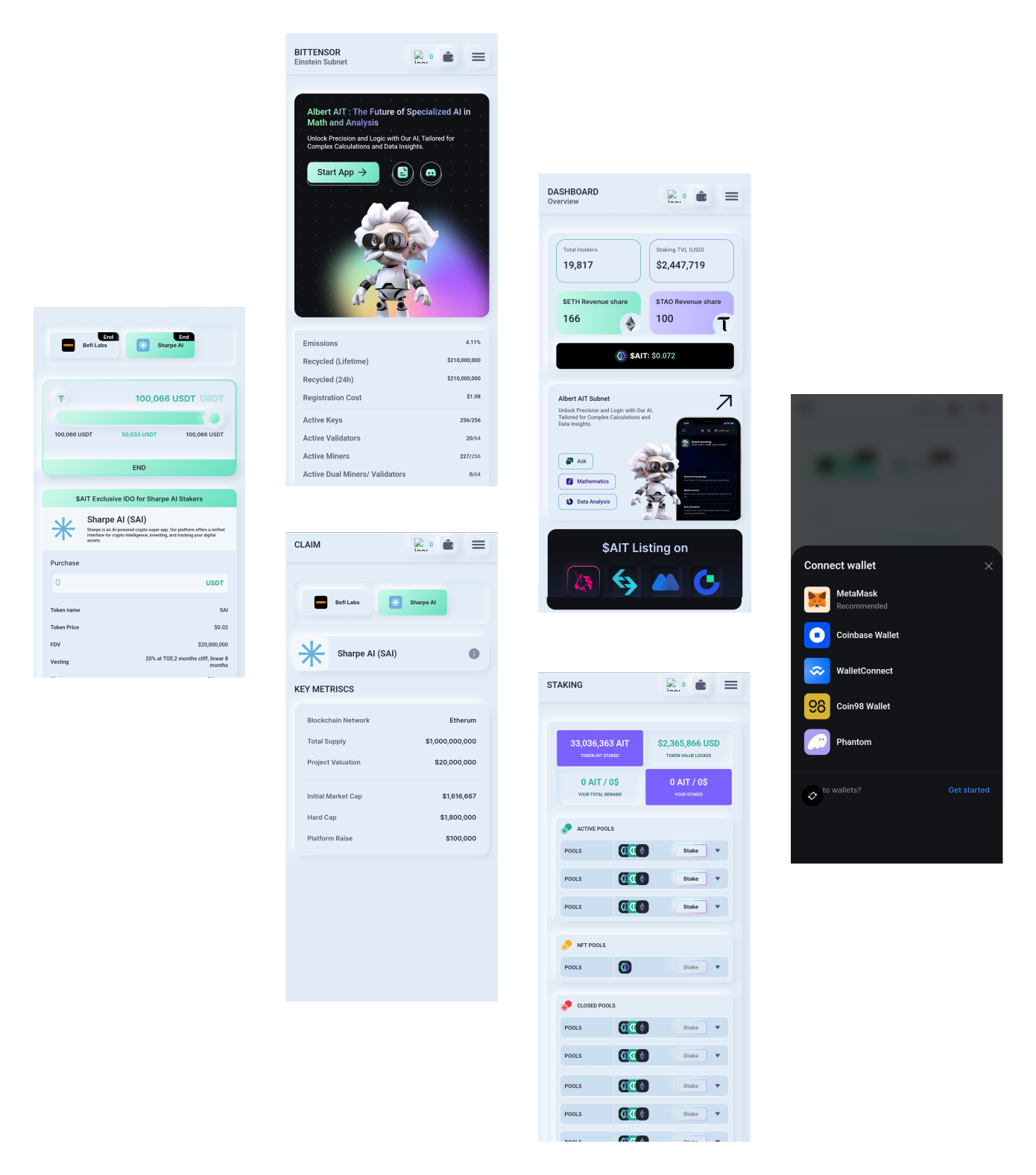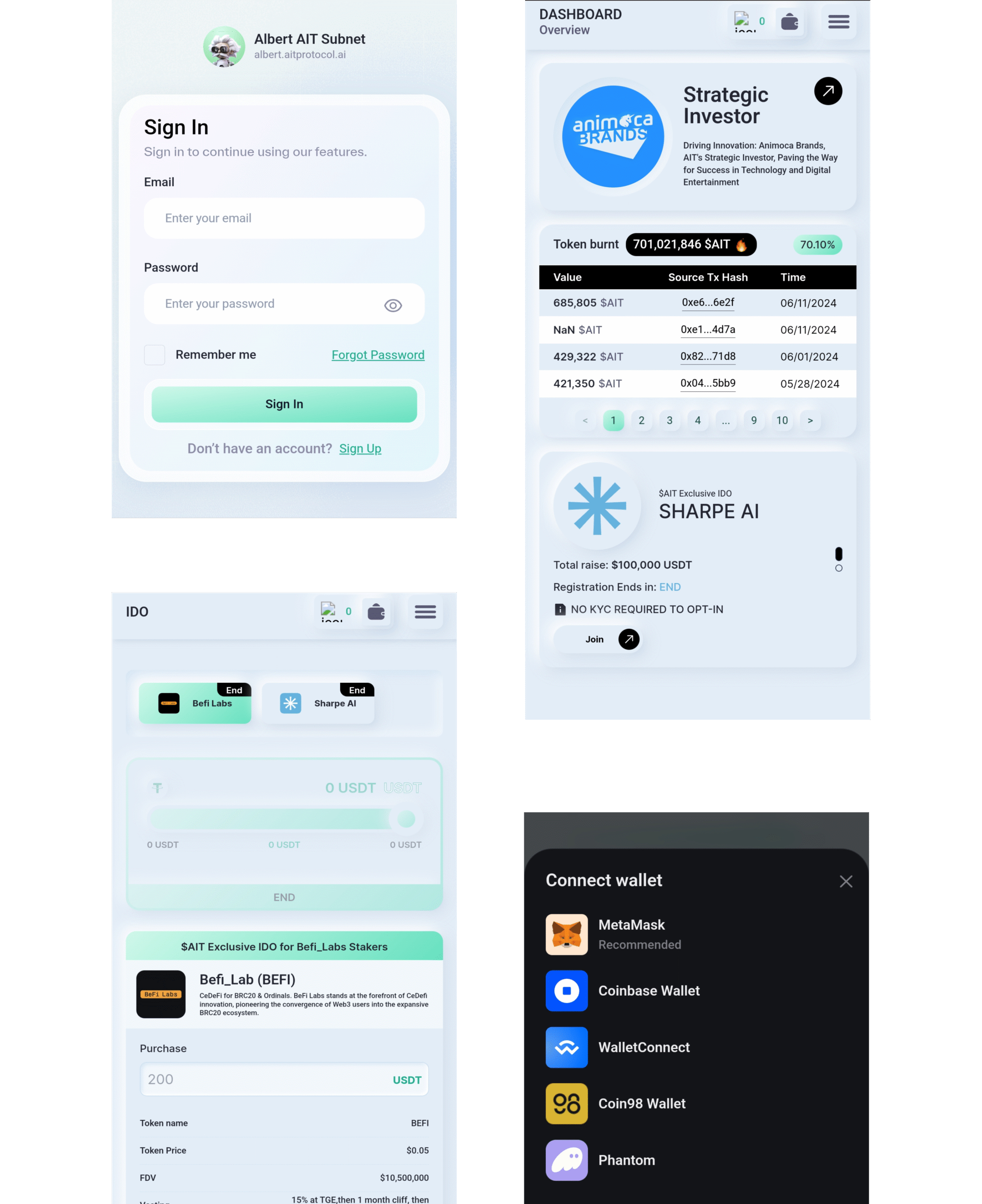
The AIT Protocol platform, accessible revolutionizes asset management through secure blockchain-based digitization and tokenization. It enables seamless creation, issuance, and management of tokens representing physical and digital assets like real estate and commodities.

The client required a platform that could seamlessly integrate AI capabilities within a decentralized framework. They emphasized the need for a highly secure and scalable system that could handle large volumes of transactions without compromising on performance. Additionally, the platform needed to be user-friendly, offering a seamless experience for both developers and end-users. Interoperability was another crucial requirement, ensuring that the platform could interact with other blockchain networks and traditional systems to provide a holistic solution.
The client also sought advanced security measures to protect user data and ensure the integrity of transactions. They wanted the platform to support Smart Contract Deployment and management, enabling various applications across different industries. Furthermore, the integration of AI was paramount to enhance the decision-making processes and functionality of the protocol. These requirements laid the foundation for the development of the AIT Protocol, driving its design and implementation.

AIT Protocol enables creation and deployment of smart contracts, allowing automated, rule-based dApps that reduce intermediaries and enhance transaction efficiency, reliability, and transparency in decentralized ecosystems.
Designed for high TPS, AIT Protocol ensures rapid processing and real-time responsiveness, supporting demanding applications like finance and supply chains without compromising performance or efficiency.
The platform uses advanced cryptography and consensus mechanisms to protect data integrity, ensuring secure transactions and fostering trust through strong, proactive defense against vulnerabilities and threats.
By integrating AI, AIT Protocol automates decisions, analyzes data, and predicts trends, offering intelligent, industry-specific solutions that enhance operational efficiency and value across various sectors.
AIT Protocol supports seamless cross-chain communication, integrating with multiple blockchains to enhance versatility, broaden use cases, and provide users with a connected, unified experience.
The intuitive design of AIT Protocol ensures accessibility for all users, simplifying onboarding and interaction to drive adoption, engagement, and platform usability across technical and non-technical audiences.
AIT Protocol features decentralized governance, empowering stakeholders to influence decisions, promote transparency, ensure accountability, and align platform evolution with community interests.
The platform distributes AI computations across the network, enhancing performance and security while eliminating single points of failure and enabling verifiable, trustworthy data processing.

AIT Protocol uses PoS, selecting validators by their staked tokens. This method cuts energy usage and aligns validators’ interests with network security, ensuring eco-friendly operations and strong consensus reliability.
By combining PoS and DPoS, AIT Protocol achieves secure, decentralized, and fast transactions. This hybrid model strengthens scalability and performance while maintaining a fair, balanced, and efficient consensus mechanism across the network.
Stakeholders vote for delegates in the DPoS system, promoting a transparent and democratic process. This voting mechanism ensures capable individuals manage the network, enhancing community trust and decentralized governance effectively.
AIT Protocol’s hybrid consensus supports high transaction throughput and low latency. This efficient structure enables smooth performance across various use cases, including large-scale enterprise solutions and advanced decentralized AI Applications.
DPoS lets stakeholders elect validators, improving efficiency and speed. A smaller validator set enhances transaction processing and reduces congestion while retaining the core security strengths of traditional staking systems.
Validators earn staking rewards based on their token commitment and performance. This incentivizes active participation, reinforcing the network’s health and encouraging users to contribute to consensus and long-term stability.
Validators are chosen based on staked tokens and votes received. This ensures they are invested in network integrity, promoting trustworthy participation and helping maintain optimal performance, and ecosystem confidence.
Security protocols include penalties for malicious actions and rewards for honest behavior. These safeguards ensure network integrity, prevent attacks, and protect user data across the blockchain’s decentralized infrastructure consistently.

Aa Bb Cc Dd Ee Ff Gg Hh Ii Jj Kk Ll Mm Nn Oo Pp Qq Rr Ss Tt Uu Vv Ww Xx Yy Zz
Project Approach The project followed a structured and systematic approach to ensure the successful implementation of the AIT Protocol. The initial phase involved a comprehensive analysis of client requirements and market research to understand the competitive landscape. This was followed by the design and architecture phase, where a scalable and secure architecture was developed to support the desired features. The development phase employed an iterative process with regular feedback loops to incorporate client and user feedback, ensuring that the platform met all requirements and expectations.
Project Results The AIT Protocol achieved significant milestones post-deployment. The platform witnessed rapid adoption within the blockchain and AI communities, reflecting its robustness and appeal. Performance metrics indicated high throughput and low latency in transaction processing, meeting the scalability requirements effectively. The security measures proved effective, with no major security breaches reported, underscoring the reliability of the implemented protocols. User feedback was overwhelmingly positive, with high satisfaction regarding the intuitive interface and seamless functionality.
Future Prospects The result of these endeavors was the creation and rollout of the mining app, which gained significant attention within the AI community. Its intuitive interface, comprehensive functionalities, and backing from a vibrant community propelled its rapid adoption. Users lauded its simplicity, dependability, and groundbreaking approach to decentralized AI development and cooperation. Consequently, the mining app saw exponential expansion, drawing in a wide-ranging and enthusiastic user community eager to participate in driving forward AI technology.

One of the main challenges in developing AIT Protocol was ensuring scalability. The system had to process a high volume of transactions per second while maintaining top performance. This demanded advanced solutions and architectural optimizations. By utilizing innovative blockchain technologies and fine-tuning the platform’s structure, the development team successfully overcame these issues, delivering the necessary throughput and efficiency without sacrificing stability or user experience.
Security was a core challenge for the AIT Protocol’s development team. Protecting user data, safeguarding transactions, and preventing vulnerabilities required advanced cryptographic solutions and multi-layered defenses. Continuous security audits, penetration testing, and real-time monitoring were implemented to identify risks early. Through rigorous measures, the platform maintained data integrity, ensured safe operations, and built user trust, providing a secure and dependable blockchain environment for every participant in the network.
Integrating the AIT Protocol with multiple blockchain networks and existing traditional systems brought several technical hurdles. Achieving smooth interoperability and stable data exchange meant addressing compatibility gaps and designing efficient APIs. The team adopted a modular integration strategy, enabling flexible interaction with different systems. This approach improved scalability, simplified maintenance, and allowed the protocol to evolve quickly while remaining adaptable to a variety of blockchain and enterprise environments.

The AIT Protocol utilized a diverse set of technologies to meet its objectives.